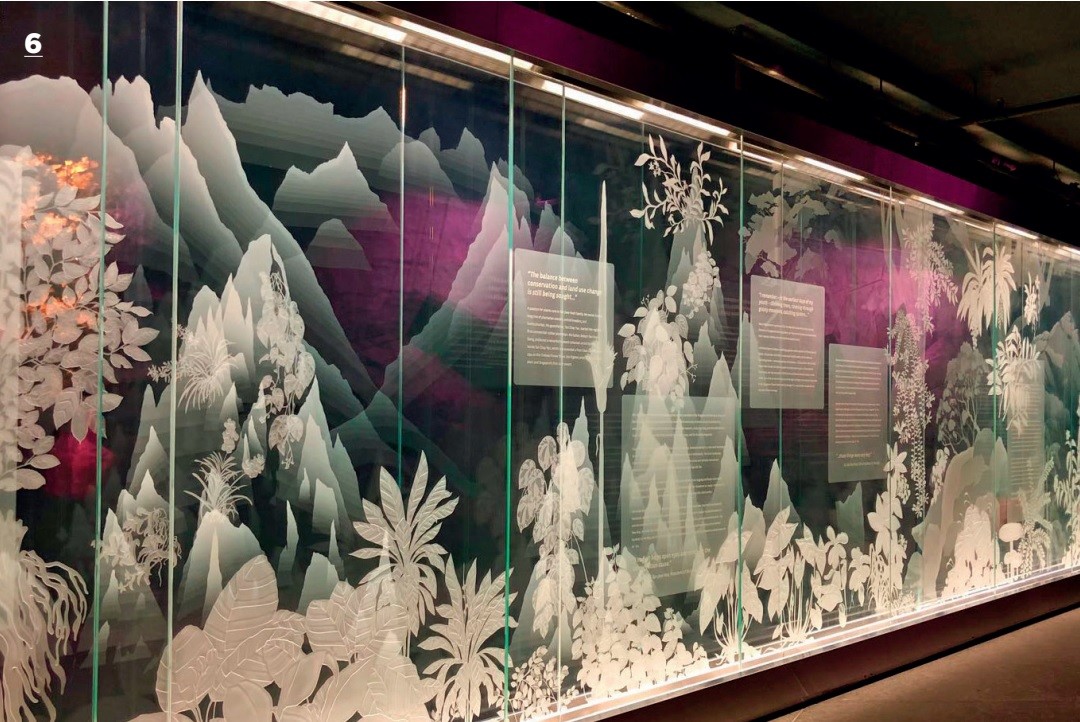Florence Ng, founder and creative director of Synergraphic Design, which specialises in glass art and design, reveals the intricacies of working with this beautiful, fragile and versatile material.


1. A stone print from the Italian Soul series from Earth Tales Volume II.
With its many styles and forms, glass has long been favoured for its visual lightness, structurally sound qualities and versatile beauty in both art and interior design. Modern visionary and a pioneer in Singapore’s glass-making field, Florence Ng sheds light on its evolution and new possibilities.
HOW DID YOU START WORKING WITH GLASS AND WHAT INSPIRED YOU?
I first encountered glass in 1984, when I supplied and installed glass in windows. Trained in advertising arts and as a graphic designer, I wanted to discover more ways to create art with it. In 1990, I flew to Europe’s biggest glass trade fair in Dusseldorf, Germany, and later to Seattle to learn the art of fusing and blowing from American glass artist and designer Roger Nachman.
I’ve had an innate passion for art and creative work since I was a child. I believe it is a gift from God. While the unique beauty of glass, its qualities and versatility inspire me, I also explore other mediums and materials to create innovative glassworks. The world is filled with inspiration. I get little sparks from everywhere – walks in the park, watching the fishes in my pond, sitting under a tree as the world goes by, and the works of others.
WHAT CAN YOU TELL US ABOUT SYNERGRAPHIC’S NEW COLLECTION, THE EARTH TALES VOLUME II?
Earth Tales Volume II offers the beauty of stone with the benefits of glass for limitless applications – from backlit feature walls and translucent doors to tabletops.
While beautiful, stone has limitations. It’s heavy, there is no control over its grain, it’s porous and susceptible to bacteria, and it can’t cover large-scale designs. We photographed or scanned various stones with different characteristics to create high-quality digital prints that can be scaled up to span large surface areas. Each is unique and grouped into different ‘souls’: French, Greek and Italian.
Bold prints make for distinctive feature walls, while subdued palettes and lines blend in with most design themes. You can also select the preferred grain sections. In keeping up with the latest technologies, we ensure high-quality products and hope that the beauty of stones in such a format will bring joy, pride and peace of mind in homes and spaces.

2. & 3. Florence coldworking glass and focusing on a custom chandelier for a private residence.

4. An artwork at the Macau Theme Park Resort.
HOW IS GLASS AS A MATERIAL EVOLVING WITHIN THE INTERIOR DESIGN INDUSTRY?
Interestingly, many collections, like the patterned and laminated art glass of our Jaipur, Mache and Shoji series offered in the early 2000s, are gaining popularity again.
The introduction of direct printing on glass has uncovered possibilities for both interiors and architecture. In the past, graphics were printed onto film and laminated between glass layers, and could only be applied using traditional and manual techniques such as stained glass, sandcarving or kiln forming.
With new printing technologies and inks, the sky’s the limit! Larger creations, economies of scale and less material usage can also be achieved, making it more accessible for all kinds of projects and applications.
The handmade quality of art glass is making a comeback through cast and kiln-formed glass, as well as gilding, for use as feature walls, furniture, lighting and wall installations. We recently produced many of these for hospitality projects in Singapore and Macau.
What’s wonderful about glass is its wide range and versatility.
Whether you’re after minimalist, highly customised or ornate and luxurious designs, you’ll be able to find something that fits your taste.

5. A wall feature at the Yellow Pot Restaurant at the former Six Senses Duxton Hotel.
“GLASS ART IS UNIQUELY BEAUTIFUL BECAUSE OF THE MATERIAL. GLASS CAN TRANSMIT AND REFLECT LIGHT TO PERFORM FUNCTIONS OF TRANSPARENCY, TRANSLUCENCY, OPACITY AND REFLECTIVITY. WOOD, METAL AND STONE CANNOT DO ANY OF THESE.”
– FLORENCE NG, SYNERGRAPHIC DESIGN
DO YOU CONSIDER GLASS A FRAGILE MATERIAL? IF SO, WHAT MAKES IT SO APPEALING?
Glass is fragile but we often fail to realise how strong it is, too. For example, stained glass windows can withstand outdoor weather conditions, and last for centuries without major deterioration.
Despite its fragility, it is highly functional and has qualities that many materials such as stone, wood or metal do not have. It is smooth and non-porous, which makes our living spaces sterile and safe, is impervious to water and dirt, and, unlike acrylic, is resistant to harsh cleaning agents.
Also, unlike other opaque materials, glass can be transparent, translucent or reflective. It can be used to physically separate spaces while retaining a sense of openness. Mirrors reflect spaces and can make a room appear larger. Advances in technology, such as tempering and lamination, have resulted in stronger glass, like bulletproof and fire-rated glass.
IS IT A SUSTAINABLE MATERIAL?
Glass is inherently sustainable. It is made from sand, soda ash and limestone, all of which are natural materials. This makes it 100 per cent recyclable.
WHAT IS THE MOST CHALLENGING ASPECT OF WORKING WITH GLASS?
It is unpredictable and fragile. You can spend a lot of time preparing the design and materials, only to have it break during or after fabrication. This tends to happen during processes that involve heat. However, many happy accidents have been discovered through this, too. Because of its transparent and reflective qualities, the appearance of glass is affected by the lighting conditions of a space. We are experienced in pre-empting such issues and often test the glass pieces in-house with various lighting conditions, but the final installed piece could still look different from what was initially expected.

6. An artwork commissioned by illustrator Sara Chong was digitally printed and sandcarved on this 16m feature wall at Gardens by the Bay.
WHAT ARE SOME COMMON MISCONCEPTIONS ABOUT GLASS?
Many often associate glass with the usual windows, tabletops or glassware. But there is so much more that can be created with this material, as seen through our collections and projects.
It is often thought to be very expensive, too. But glass can be cheaper and perform better than acrylic, which attracts dust, is easily scratched and warps when produced in large formats.
THERE IS AN INCREASING USE OF TECHNOLOGY WITH GLASS, LIKE SMART GLASS AND ANTIMICROBIAL COATING. IS THIS THE FUTURE OF GLASS?
Glass is simply irreplaceable for various reasons. Hence, it makes sense to develop technologies to widen its possibilities, and to overcome more of its existing limitations.
We will soon launch a new product with antibacterial properties that is great for both private and public places, especially in the light of Covid-19.
Technology aside, the artistic part of the equation is also important in transforming spaces. Our desire is to combine modern technology with traditional methods of glass working to create new possibilities.
WHAT ARE SOME UNIQUE PROJECTS SYNERGRAPHIC IS WORKING ON NOW?
We are working on highly decorative crystal cast glass features with palladium leaf backing for Apex Gaming at the 2020 Macau Gaming Show at The Venetian Macao. These showcase sculptural birds with flora and fauna in a chinoiserie style.
We are also attempting something bold for a local church project, which we are very excited about. Traditional stained glass panels will be laid over digitally printed glass for four facade windows. It is incredibly challenging as the overall look has to be cohesive despite the limitations of each technique. They also have to look good during the day and the night. The project is slated to be completed by the end of this year.
By the way, we recently completed a unique dome for a private residence in Colombo, Sri Lanka, that was meant to resemble a large crystal gemstone but was cleverly executed with stained glass.

7. The marble’s monochromatic beauty lends itself to this glass feature with the Argos print from the Earth Tales Volume II line-up
Text MICHELLE LEE























